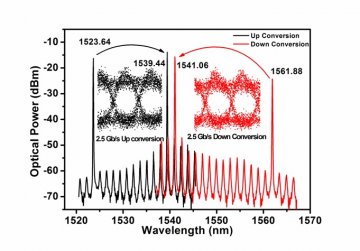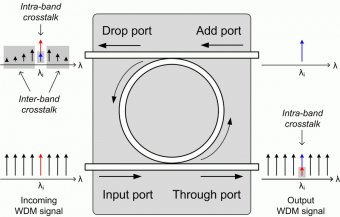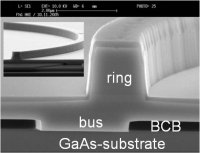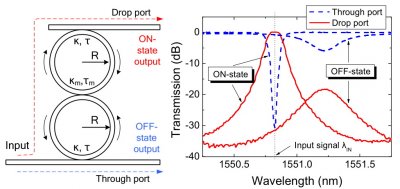2.2 Multifunctional microring devices
Active rings as potential devices in access networks
Active microring devices can operate as laser sources in future WDM networks and have shown to be quite promising components for all-optical signal processing applications. The lack of need for cleaved facets as well as their simple fabrication process makes them suitable for dense photonics integration. The photonics lab has been conducting experiments with active and passive microring components mainly within the scope of the European project WAPITI. Our group is involved in waveguide designing aspects of such devices, static and dynamic performance simulation and in their experimental characterization. Active and passive microrings, as well as active-passive integrated ones have been measured and along with the theoretical support by analytical models have produced results already published.
Tunability of double-ring lasers
Active microrings coupled with passive bus waveguides allow tuning of the emission wavelength through a coupled-cavity Vernier effect. Separate electrical contacts enable independent control of the different rings increasing this way their volatility. By choosing the relative radii of the two microring lasers the desired ratio of free-spectral-ranges is obtained which through the Vernier effect and thermal tuning results in very high side mode suppression ratios (exceeding 40dB) and broad wavelength tuning which spans more than 40nm. Tuning speed is relative to the spectral distance between the switching modes and can range from ms down to ns for closely placed wavelengths.
Active-Passive Integrated Microring Lasers
The active-passive integration technology developed within the scope of the WAPITI project produced interesting devices that include active ring cavities, vertically coupled with passive bus waveguides through a wafer bonding process. These devices went under thorough investigation and are showed very attractive characteristics. Apart from the static performance which shows single longitudinal behavior for a broad range of injection current values, especially for compact rings (e.g. radius 50um), the devices are also tested under modulation. Up to now, modulation rates up to 7Gb/s have been recorded corresponding in error free (BER<10^-12) for back to back measurements.
Wavelength Conversion in Active-Passive Microring
 Active microrings can also be used for tunable wavelength conversion exploiting the cross gain modulation (XGM) mechanism . The major advantage of the conversion system is the wide range of wavelengths from which the input signal can be converted. The output wavelengths are controlled by the current injected into the laser diode without any need of external tunable pump module or any other wavelength-selection mechanism. This adds accuracy and reproducibility in the determination of the desired wavelengths, especially in multi-wavelength applications where the alignment of the wavelengths with the wavelength-division-multiplexing grid is critical.
Active microrings can also be used for tunable wavelength conversion exploiting the cross gain modulation (XGM) mechanism . The major advantage of the conversion system is the wide range of wavelengths from which the input signal can be converted. The output wavelengths are controlled by the current injected into the laser diode without any need of external tunable pump module or any other wavelength-selection mechanism. This adds accuracy and reproducibility in the determination of the desired wavelengths, especially in multi-wavelength applications where the alignment of the wavelengths with the wavelength-division-multiplexing grid is critical.
Passive Microring based Add / Drop Filters
During the past years a considerable effort has been put into the realization of all optical network components using microring resonators. Among the several applications based on microrings, filters, add/drop multiplexers, optical gates, wavelength converters provide an extremely practical solution for near future optical networks due to their small size, capability of  integration, and the low manufacturing cost. In particular, optical filters, multiplexers and switches based on microrings have been in our attention and our main effort focused on the evaluation of their performance under conditions similar to those of a real network. Various models have been developed in order to simulate their dynamic behaviour e.g. operation with time dependent modulated signals.
integration, and the low manufacturing cost. In particular, optical filters, multiplexers and switches based on microrings have been in our attention and our main effort focused on the evaluation of their performance under conditions similar to those of a real network. Various models have been developed in order to simulate their dynamic behaviour e.g. operation with time dependent modulated signals.
Most significant results showed that the simultaneous add and drop process in such single-stage filters induces induces severe impairments on the signals through the inter-band and the intra-band crosstalk. Multistage add/drop topologies that address the inefficiencies of the single stage add-drop filters are proposed and theoretically investigated for operation up to 40 Gbps.
Moreover, an optical switch suitable for optical burst switching systems and metro architectures was proposed and investigated. It provides fast optical switching in the ns scale with contrast ratio higher than 30 dB for 10 Gbps intensity modulated signals. The capacity of the switch could be remarkably increased if multi-wavelength switching is employed.
Related projects:
- E-photon/One
- WAPITI
- E-photon/One+
- BONE
Significant publications:
- A. Kapsalis, I. Stamataki, S. Mikroulis, D. Syvridis, M. Hamacher, “Widely Tunable All-Active Micro-Ring Lasers”, IEEE Photonics Technology Letters, vol. 18, no. 24, pp. 2641-2643, 2006.
- A. Kapsalis, D. Alexandropoulos, S. Mikroulis, H. Simos, I. Stamataki, and D. Syvridis, M. Hamacher, U. Troppenz, and H. Heidrich, “Spectral properties of all-active InP-based microring resonator devices”, Proceedings of the SPIE, Volume 6115, pp. 386-394, 2006.
- A. Kapsalis, I. Stamataki, D. Syvridis, M. Hamacher, “Widely Tunable All-Active Micro-Ring Lasers through Phase Shifted Controlled Feedback”, We 3.52 ECOC 2006.
- A. Kapsalis, U. Troppenz, M. Hamacher, H. Heidrich and D. Syvridis, “7Gb/s Direct Modulation of Vertically Coupled Microring Lasers,” OFC 2008, 24-28 February 2008, San Diego, California, USA.
- D. Syvridis, H. Simos, S. Mikroulis, and A. Kapsalis, “Microring-based devices for telecommunication applications,” Proceedings of the SPIE, Vol. 7211, (2009)
- A. Kapsalis, H. Simos, D. Syvridis, M. Hamacher, H. Heidrich, “Tunable Wavelength Conversion using Cross Gain Modulation in a Vertically Coupled Microring Laser,” IEEE Photonics Technology Letters, vol. 21, no. 21, pp. 1618-1620 (2009)
- A. Kapsalis, D. Syvridis, M. Hamacher, H. Heidrich, “Broadly Tunable Laser using Double-Rings Vertically Coupled to a Passive Waveguide”, IEEE Journal of Quantum Electronics, vol. 46, no. 3, pp. 306-312 (2010)
- A. Kapsalis, C. Mesaritakis, D. Syvridis, “Design and Experimental Evaluation of Active-Passive Integrated Microring Lasers”, ESWL Lauzanne (2011)
- A. Kapsalis, I. Stamataki, C. Mesaritakis, D. Syvridis, M. Hamacher, H. Heidrich, “Design and Experimental Evaluation of Active-Passive Integrated Microring Lasers: Threshold Current and Spectral Characteristics”, submitted for publication to IEEE Journal of Quantum Electron. (2011)
- A. Kapsalis, I. Stamataki, C. Mesaritakis, D. Syvridis, M. Hamacher, H. Heidrich, “Design and Experimental Evaluation of Active-Passive Integrated Microring Lasers: Noise Properies”, submitted for publication to IEEE Journal of Quantum Electron. Semiconductor Optoelectronic Devices special issue, 2011
- H. Simos, C. Mesaritakis, D. Alexandropoulos, and D. Syvridis, "Intra-band Crosstalk Properties of Add/Drop Filters Based on Active Microring Resonators", IEEE Photonics Technology Letters, vol. 19, 20, pp. 1649-1651, 2007.
- H. Simos, C. Mesaritakis, D. Alexandropoulos, and D. Syvridis, "Dynamic analysis of crosstalk performance in microring based add/drop filters", Journal of Lightwave Technology, vol. 27, pp. 2027-2034, 2009.
- H. Simos, A. Bogris, N. Raptis, and D. Syvridis, "Dynamic properties of a WDM switching module based on active microring resonators", IEEE Photonics Technology Letters, vol. 22, pp. 206-208, 2010.



